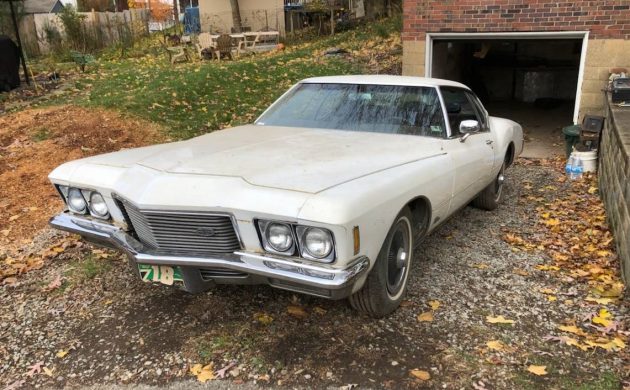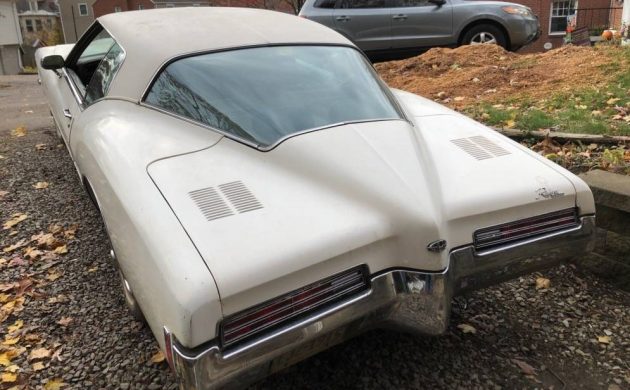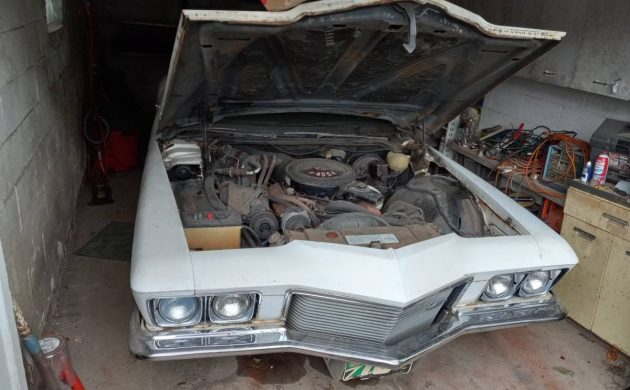Buick was not afraid of pushing the envelope on styling in the 1960s/1970s. Examples include the “swoopy” looks of the ’68 Skylark, followed by the ’71 “boattail” Riviera, including the seller’s car. Buick had hoped the change in styling of its personal luxury car would improve sales (but it didn’t). This 1971 Riviera is said to have less than 48,000 miles and comes with some original paperwork. It has emerged from a basement garage in Steubenville, Ohio, and is available here on craigslist for $10,000 firm. Thanks, Pat L., for turning us on to this old Buick!
Buick would create the Riviera in 1963 to join the ranks of the Ford Thunderbird in the personal luxury segment. Sales had slowed some by the turn of the decade at 37,336 units in 1970. So, the third-generation cars for 1971-73 would look quite different yet netted 10% few cars in 1971 at 33,810 units. The boattail look may have been too radical for some buyers, so the styling was toned down for 1972 but sales stayed flat for much of the ‘70s.
All ’71 Riviera’s had Buick’s 455 cubic-inch big-block V8 with a 4-barrel carburetor. Output was 255 hp due to a change in rating systems and some detuning to run on unleaded fuel. The one in the seller’s car is said to run well and is paired with a TH-400. It’s numbers-matching and may not have been apart given the low reported mileage of the automobile. The seller doesn’t elaborate on the background of this Buick, but we get the impression it has lived in a basement garage for a while and gets to see daylight from time to time.
The white paint and matching vinyl top seem to have held up okay and there is no evidence of rust. A good detailing might help it present better, but a new paint job might not be far off. The brown/tan leather interior looks tidy, and the bucket seats and console are a great plus. While the motor is likely stock, we’re told the engine is fitted with a set of headers and dual exhaust. So, it probably sounds as great as it runs. Hagerty estimates that a ’71 Riviera in Good Condition can be a $19,000 proposition, so if this car only needs TLC, it might be a good catch.






This is the best looking of the Boat Tails, also I believe the styling was toned down in ’73 because of the new bumper mandates. 71-72 Rivs look basically the same.
That is correct and those bumpers were ugly
Correct! The front bumper on the ’73 Rivieras was that federal-mandated monstrosity. However, there was no federal mandate for rear bumpers until ’74 but Buick went ahead and softened or toned down the rear bumper styling on the ’73 due to consumer disdain for the sharply peaked ’71 and ’72 Rivieras. But, to me, that was what made them so beautiful and radical.
I thought for ’72, the front bumpers must take a 2.5 mph hit(reasonable IMO).
& for ’73, the front bumpers, a 5 mph hit & rear, a 2.5 mph hit.
This is a first-ballot classic for me. I will have one someday.
I had a ’71 boattail and got nothing but praise and ‘thumbs up’ for it. I yearn to have another. Even dirty it’s such a beautiful classic!
So, I wonder why they have the vents on both sides of the rear trunk lid? something to do with water run-off and the rear window “swoop”?
Louvers in the trunk lid were there to equalize pressure from the flow through ventilation. ’72 and later had smaller vents in the door jambs.
In 1971, the GENERAL had trunk vents on all of their full size cars. GM said as long as the key was in the on position, a fan was moving air. Drawing air into from the cowl, through the HVAC system, the air was pushed out through the vents in the trunk lid. This 1 year use of trunk vents was discontinued for 1972.
Most all ‘71 GM cars had the trunk vents, not just the Riv.
Those vents draw air through passegesin the body all the way from the front fenders to dry out the water that gets in past the lousy seals. Works great to prevent rot, if you drive it regularly. Let it sit out and even the galvanized steel will rust out. Besides, the lovers just look cool.
My Mom ( ALL 4′ 11” OF HER ) Had one in the mid 80’s and it had been worked over a little bit. That 455 was a torque monster and I never found the top end. Use to PI$$ my little sister off when I came home on leave and used mom’s RIV to smoke her Vette. Mom’s about 4’9” NOW and in her 80’s but I’d love to drive this over to Pa. and give it to her. Nice Ride .
Output was 255 hp due to a change in rating systems and some detuning to run on unleaded fuel. In 1971? Why? Leaded fuel was commonly in use then. It wasn’t until 1975 that cars required unleaded due to catalytic converters.
I’m guessing to make spark plugs last longer even in ’71 if you chose to use unleaded. & later especially complementing HEI on some motors starting midway ’74 model year which would triple conventional spark plug life & decrease emissions.
Government intervention,
Nanny country.
Please make make more mandates so we never get to drive a car?
1971 the Riviera 455-4 made 315hp and 330 in GS tune…methinks you are quoting 1972 figures lad.
I have a 72 and I’m pretty sure that the seats are vinyl not leather.
1st gen these & same from Toranado remind me of the great cars of the era.
Neat lookin louvers, hope they don’t go thru (R just mock).
The louvers didn’t go through but water sure did. I was originally looking for a 71 boattail but every one I saw had water issues in the trunk so I went for a 72 when they got rid of the louvers.
The tear in the top above the quarter window and bubbling underneath is concerning.
Underneath might be a nightmare. The interior looks like it may have been flooded there rust all along the front end behind the bumper and there is evidence of water/mud on the garage floor and walls. Also why no exterior walk around photos since the car is out of the garage?
Good eye. Mildew on the seatbelt (visible in the photo showing the console and shifter, which also show signs of water) is concerning. This definitely requires and in-person inspection, unless a buyer is already planning a frame-off resto.
Lower octane called for in ’71 emissions standards resulted in lowered compression and horsepower. In ’72 HP ratings were changed from net to SAE, resulting in lower #’s but no change in actual power output. Yes, ’75 was the year for unleaded gas and catalytic converters.
I had 73 stage 1 boat tail and also have one of the sloopy designed skylarks referred to nut mine is a 69 gs 400 4 speed rag top bench seat owned for 51 years 78350 original miles signal red black vinyl seats white top new paint early 21 keeping to all original except radio and added power steering this car hsd no poeer anything except top and The 400 340 hp engine
Basements are damp period. I keep my 50 year old Corvette in my basement garage sitting on 3 old rugs and cardboard. Plus dehumidifier and mouse traps every where. Love this Riv. My step brother has a 73 in dark blue. Has owned since 1979. This car is 50 years old and we all know GM cars RUST. Buyer do your homework.
Guy wants paid by CashApp: a well known scammer ploy.
@joenywf64
Regarding federally mandated safety bumpers, the following is copied from an article in the Hagerty Car Insurance online magazine dated February 8, 2021. It discusses the regulations as they became law. And it says;
“The first U.S. bumper regulations appear to have been part of NHTSA Federal Motor Vehicle Safety Standard No. 215 (FMVSS 215), “Exterior Protection.” They took effect in September 1972, so from a practical standpoint, they were enacted by most manufacturers for the 1973 model year. These 1973-only bumpers are often referred to as “2 ½-mph bumpers,” but that’s a bit of a misnomer. Standard 215 required that the bumpers protect safety-related systems and components such as lighting during 5-mph direct front impact tests and 2 ½-mph rear tests.
But for model year 1974, the bumper standard changed again, requiring that the car’s lighting remains intact on impacts of 5 mph both front and back, and from any angle.”
@Steve Jenks
You wrote: “In ’72 HP ratings were changed from net to SAE, resulting in lower #’s but no change in actual power output.”
Actually, before 1972, horsepower was rated in gross figures. Then, in 1972, they changed to net horsepower ratings.
@Brent
You wrote: “Most all ‘71 GM cars had the trunk vents, not just the Riv.”
I never have understood the sporadic use of the trunk louvers on SOME GM cars. The ones I can think of that had them are the full-size Chevrolet, the Cadillac Eldorado, the full-size Pontiac, the full-size Oldsmobile, the full-size Buick and even the lowly Vega!